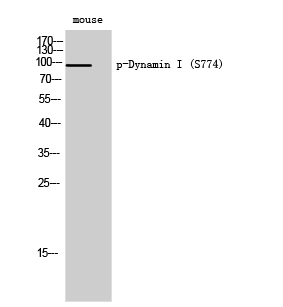Dynamin I (phospho Ser774) Polyclonal Antibody
- SPECIFICATION
- CITATIONS
- PROTOCOLS
- BACKGROUND

Application
| WB, IHC-P |
|---|---|
| Primary Accession | Q05193 |
| Reactivity | Human, Mouse, Rat |
| Host | Rabbit |
| Clonality | Polyclonal |
| Calculated MW | 97408 Da |
| Gene ID | 1759 |
|---|---|
| Other Names | DNM1; DNM; Dynamin-1 |
| Dilution | WB~~Western Blot: 1/500 - 1/2000. Immunohistochemistry: 1/100 - 1/300. ELISA: 1/5000. Not yet tested in other applications. IHC-P~~N/A |
| Format | Liquid in PBS containing 50% glycerol, 0.5% BSA and 0.09% (W/V) sodium azide. |
| Storage Conditions | -20℃ |
| Name | DNM1 (HGNC:2972) |
|---|---|
| Synonyms | DNM |
| Function | Catalyzes the hydrolysis of GTP and utilizes this energy to mediate vesicle scission and participates in many forms of endocytosis, such as clathrin-mediated endocytosis or synaptic vesicle endocytosis as well as rapid endocytosis (RE) (PubMed:15703209, PubMed:20428113, PubMed:29668686, PubMed:8101525, PubMed:8910402, PubMed:9362482). Associates to the membrane, through lipid binding, and self-assembles into rings and stacks of interconnected rings through oligomerization to form a helical polymer around the vesicle membrane leading to constriction of invaginated coated pits around their necks (PubMed:30069048, PubMed:7877694, PubMed:9922133). Self-assembly of the helical polymer induces membrane tubules narrowing until the polymer reaches a length sufficient to trigger GTP hydrolysis (PubMed:19084269). Depending on the curvature imposed on the tubules, membrane detachment from the helical polymer upon GTP hydrolysis can cause spontaneous hemifission followed by complete fission (PubMed:19084269). May play a role in regulating early stages of clathrin-mediated endocytosis in non-neuronal cells through its activation by dephosphorylation via the signaling downstream of EGFR (PubMed:29668686). Controls vesicle size at a step before fission, during formation of membrane pits, at hippocampal synapses (By similarity). Controls plastic adaptation of the synaptic vesicle recycling machinery to high levels of activity (By similarity). Mediates rapid endocytosis (RE), a Ca(2+)-dependent and clathrin- and K(+)-independent process in chromaffin cells (By similarity). Microtubule-associated force-producing protein involved in producing microtubule bundles and able to bind and hydrolyze GTP (By similarity). Through its interaction with DNAJC6, acts during the early steps of clathrin-coated vesicle (CCV) formation (PubMed:12791276). |
| Cellular Location | Cell membrane. Membrane, clathrin-coated pit. Cytoplasmic vesicle {ECO:0000250|UniProtKB:P21575, ECO:0000250|UniProtKB:P39053} Presynapse {ECO:0000250|UniProtKB:P21575}. Cytoplasmic vesicle, secretory vesicle, chromaffin granule {ECO:0000250|UniProtKB:Q08DF4} Note=Associated to the membrane in a helical polymer shape in a GTP bound state (PubMed:30069048). Transiently recruited to endocytic clathrin-coated pits (CCPs) at a late stage of clathrin-coated vesicle (CCV) formation (PubMed:15703209). |

Thousands of laboratories across the world have published research that depended on the performance of antibodies from Abcepta to advance their research. Check out links to articles that cite our products in major peer-reviewed journals, organized by research category.
info@abcepta.com, and receive a free "I Love Antibodies" mug.
Provided below are standard protocols that you may find useful for product applications.
Background
Microtubule-associated force-producing protein involved in producing microtubule bundles and able to bind and hydrolyze GTP. Most probably involved in vesicular trafficking processes. Involved in receptor-mediated endocytosis.
If you have used an Abcepta product and would like to share how it has performed, please click on the "Submit Review" button and provide the requested information. Our staff will examine and post your review and contact you if needed.
If you have any additional inquiries please email technical services at tech@abcepta.com.













 Foundational characteristics of cancer include proliferation, angiogenesis, migration, evasion of apoptosis, and cellular immortality. Find key markers for these cellular processes and antibodies to detect them.
Foundational characteristics of cancer include proliferation, angiogenesis, migration, evasion of apoptosis, and cellular immortality. Find key markers for these cellular processes and antibodies to detect them. The SUMOplot™ Analysis Program predicts and scores sumoylation sites in your protein. SUMOylation is a post-translational modification involved in various cellular processes, such as nuclear-cytosolic transport, transcriptional regulation, apoptosis, protein stability, response to stress, and progression through the cell cycle.
The SUMOplot™ Analysis Program predicts and scores sumoylation sites in your protein. SUMOylation is a post-translational modification involved in various cellular processes, such as nuclear-cytosolic transport, transcriptional regulation, apoptosis, protein stability, response to stress, and progression through the cell cycle. The Autophagy Receptor Motif Plotter predicts and scores autophagy receptor binding sites in your protein. Identifying proteins connected to this pathway is critical to understanding the role of autophagy in physiological as well as pathological processes such as development, differentiation, neurodegenerative diseases, stress, infection, and cancer.
The Autophagy Receptor Motif Plotter predicts and scores autophagy receptor binding sites in your protein. Identifying proteins connected to this pathway is critical to understanding the role of autophagy in physiological as well as pathological processes such as development, differentiation, neurodegenerative diseases, stress, infection, and cancer.


